Battle pf the heavyweights CM gets together the first of
Page 20
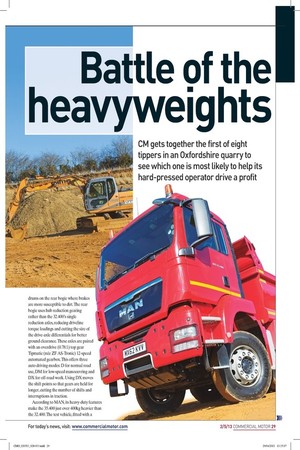
Page 19
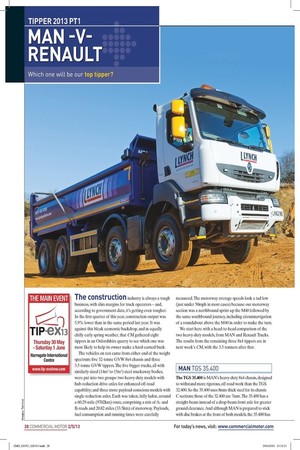
Page 21
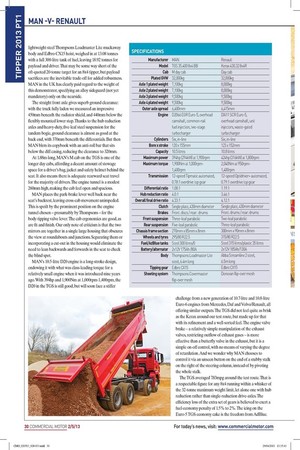
Page 22

Page 23
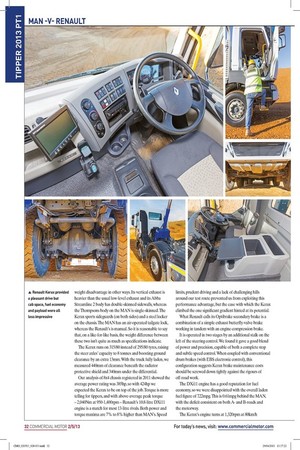
Page 24
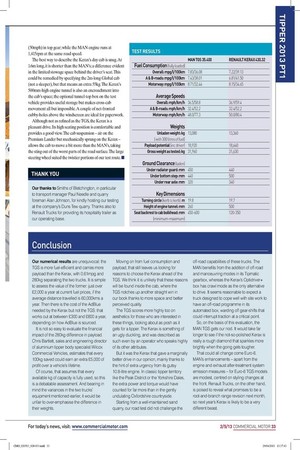
If you've noticed an error in this article please click here to report it so we can fix it.
eight tippers in an Oxfordshire quarry to , see which one is most likely to help its hard-pressed operator drive a profit The construction industry is always a tough business, with slim margins for truck operators — and, according to government data, it's getting even tougher. In the first quarter of this year, construction output was 5.9% lower than in the same period last year. It was against this bleak economic backdrop, and in equally chilly early spring weather, that CM gathered eight tippers in an Oxfordshire quarry to see which one was most likely to help its owner make a hard-earned buck.
The vehicles on test came from either end of the weight spectrum: five 32-tonne GVVV 8x4 chassis and three 3.5-tonne GVVV tippers. The five bigger trucks, all with similarly sized (14m3 to 15m3) steel muckaway bodies, were put into two groups: two heavy-duty models with hub-reduction drive-axles for enhanced off-road capability; and three more payload-conscious models with single-reduction axles. Each was taken, fully laden, around a 60.29-mile (9702km) route, comprising a mix of Aand B-roads and 20.82 miles (33.5km) of motorway. Payloads, fuel consumption and running times were carefully measured. The motorway average speeds look a tad low (just under 50mph in most cases) because our motorway section was a northbound sprint up the M40 followed by the same southbound journey, including circumnavigation of a roundabout above the M40 in order to make the turn.
We start here with a head-to-head comparison of the two heavy-duty models, from MAN and Renault Trucks. The results from the remaining three 8x4 tippers are in next week's CM, with the 3.5-tonners after that.
MAN TGS 35.400 The TGS 35.400 is MAN's heavy-duty 8x4 chassis, designed to withstand more rigorous, off-road work than the TGS 32.400. So the 35.400 uses 8mm-thick steel for its chassis C-sections; those of the 32.400 are 7mm The 35.400 has a straight-beam instead of a drop-beam front axle for greater ground clearance. And although MAN is prepared to stick with disc brakes at the front of both models, the 35.400 has drums on the rear bogie where brakes are more susceptible to dirt. The rear bogie uses hub reduction gearing rather than the 32.400's single reduction axles, reducing driveline torque loadings and cutting the size of the drive-axle differentials for better ground clearance. These axles are paired with an overdrive (0.78:1) top gear Tipmatic (née ZF AS-Tronic) 12-speed automated gearbox. This offers three auto driving modes: D for normal road use, DM for low-speed manoeuvring and DX for off-road work. Using DX moves the shift points so that gears are held for longer, cutting the number of shifts and interruptions in traction.
According to MAN, its heavy-duty features make the 35.400 just over 400kg heavier than the 32.400. The test vehicle, fitted with a lightweight steel Thompsons Loadmaster Lite muckaway body and Edbro CX15 hoist, weighed in at 13.08 tonnes with a full 300-litre tank of fuel, leaving 18.92 tonnes for payload and driver. That may be some way short of the oft-quoted 20-tonne target for an 8x4 tipper, but payload sacrifices are the inevitable trade-off for added robustness. MAN in the UK has clearly paid regard to the weight of this demonstrator, specifying an alloy sideguard (not yet mandatory) only on the nearside.
The straight front axle gives superb ground clearance: with the truck fully laden we measured an impressive 450mm beneath the radiator shield, and 440mm below the flexibly mounted lower step. Thanks to the hub reduction axles and heavy-duty, five-leaf steel suspension for the tandem bogie, ground clearance is almost as good at the back end, with 370mm beneath the differentials. But then MAN blots its copybook with an anti-roll bar that sits below the cliff casing, reducing the clearance to 320mm At 1.88m-long, MAN's M cab on the TGS is one of the longer day cabs, affording a decent amount of stowage space for a driver's bag, jacket and safety helmet behind the seat. It also means there is adequate rearward seat travel for the majority of drivers. The engine tunnel is a modest 260mm high, making the cab feel open and spacious.
MAN places the park-brake lever well back near the seat's backrest, leaving cross-cab movement unimpeded. This is spoilt by the prominent position on the engine tunnel chosen — presumably by Thompsons — for the body-tipping valve lever. The cab ergonomics are good, as are fit and finish. Our only note of criticism is that the two mirrors are together in a single large housing that obscures the view at roundabouts and junctions. Separating them or incorporating a cut-out in the housing would eliminate the need to lean backwards and forwards in the seat to check the blind spot.
MAN's 10.5-litre D20 engine is a long-stroke design, endowing it with what was class-leading torque for a relatively small engine when it was introduced nine years ago. With 394hp and 1,900Nm at 1,000rpm-1,400rpm, the D20 in the TGS is still good, but will soon face a stiffer challenge from a new generation of 10.7-litre and 10.8-litre Euro-6 engines from Mercedes, Daf and Volvo/Renault, all offering similar outputs. The TGS did not feel quite as brisk as the Kerax around our test route, but made up for that with its refinement and a well-sorted feel. The engine valve brake — a relatively simple manipulation of the exhaust valves, restricting outflow of exhaust gases — is more effective than a butterfly valve in the exhaust, but it is a simple on-off control, with no means of varying the degree of retardation. And we wonder why MAN chooses to control it via an unseen button on the end of a stubby stalk on the right of the steering column, instead of by pivoting the whole stalk.
The TGS averaged 783mpg around the test route. That is a respectable figure for any 8x4 running within a whisker of the 32-tonne maximum weight limit, let alone one with hub reduction rather than single-reduction drive-axles. The efficiency loss of the extra set of gears is believed to exert a fuel-economy penalty of 1.5% to 2%. The icing on the Euro-5 TGS economy cake is the freedom from AdBlue. SPECIFICATIONS Manufacturer Model Cab Plated GVW Axle 1 plated weight Axle 2 plated weight Axle 3 plated weight Axle 4 plated weight Outer axle spread Engine Cylinders Bore x stroke Capacity Maximum power Maximum torque Transmission Differential ratio Hub reduction ratio Overall final drive ratio Clutch Brakes Front suspension Rear suspension Chassis frame section MAN TGS 35.400 8x4 BB M day cab 32,000 kg 7,100kg 7,100kg 9,500kg 9,500kg 6,400mm D2066 FOR Euro-5, overhead camshaft, common-rail fuel injection, two-stage turbocharger Six, in-line 120 x 155mm 10.5 litres 394hp (294MM at 1,900rpm 1,900Nm at 1,000rpm 1,400rpm 12-speed Tipmatic automated, 0.78:1 overdrive top gear 1.08:1 4.0:1 4.33:1 Single plate, 430mm diameter Front: discs/ rear: drums Three-leaf parabolic Five-leaf parabolic 270mm x 85mm x 8mm Renault Kerax 430.32 8x4R Day cab 32,000kg 8,000 kg 8,000 kg 9,500kg 9,500kg 6,415mm DXi11 SCR Euro-5, overhead camshaft, unit injectors, waste-gated turbocharger Six, in-line 123 x 152mm 10.8 litres 424hp (316kINJ at 1,800rpm 2,040Nm at 950rpm 1,400rpm 12-speed Optidriver+ automated, 0.79:1 overdrive top gear 1.19:1 3.46:1 4.12:1 Single plate, 430mm diameter Front: drums/ rear: drums Two-leaf parabolic Three-leaf parabolic 300mm x 90mm x 8mm Wheels and tyres FueVAd Blue tanks Battery/alternator Body Tipping gear Sheeting system 295/80 R22.5 Steel 300 litres/0 2x12V175Ah /80A Thompsons Loadmaster Lite steel, 64m long Edbro CX15 Thompsons Covermaster flip-over mesh 315/80 R22.5 Steel 315 litres/plastic 35 litres 2x12V185Ah/130A Abba Streamline 2 steel, 6.5m long Edbro CX15 Donovan flip-over mesh RENAULT KERAX 430.32 The Kerax 430.32 is the middle option of Renault's three 8x4 tipper chassis, with the Premium Lander below it and the Kerax Heavy above. The last of these three is built for extensive use on the roughest off-road surfaces, and boasts a heavy-duty rear bogie. The Premium Lander should be specified when at least 90% of the truck's use is on-road. That leaves the Kerax for when off-road use is somewhere between these two extremes.
There are many differences between the 8x4 Kerax and Lander. Both have the same chassis frames (with 5mmthick reinforcing liners) and have hub-reduction axles in their double-drive bogie, but the Kerax axles have higher design weights and use drum brakes instead of discs, making them more resilient to off-road conditions and cheaper to maintain. And because a Kerax is expected to spend more time off-road in low gears, its 12-speed automated Optidriver+ gearbox has an overdrive top gear and slightly longer ratios throughout, followed by a bigger step-down ratio (3.46:1) in the hub reduction gears. This keeps the prop-shaft and half-shafts rotating at higher speeds, reducing torque loads through the driveline. The Lander, meanwhile, is likely to spend more time in top gear so its Optidriver+ box has a direct-drive top gear for better on-road fuel consumption.
The downside of this rough-tough specification is more weight, with the Kerax chassis-cab weighing about 800kg more than the equivalent Premium Lander, according to Renault's data. Specifications indicate the Kerax chassiscab is 615kg heavier than the heavy-duty TGS, but the weighbridge is the true arbiter and the actual difference between our two bodied examples was far less. The Kerax weighed in at 280kg more than the TGS, with both trucks carrying 300 litres of fuel, giving the Kerax a payload potential of 18.64 tonnes, including the driver.
Although both trucks have Edbro CX15 tipping gear and similarly sized (14m3-15m3) steel muckaway bodies, it is only fair to point out that this particular Kerax, sourced through big tipper and grab hire operator Lynch, is at a weight disadvantage in other ways. Its vertical exhaust is heavier than the usual low-level exhaust and its Abba Streamline 2 body has double-skinned sidewalls, whereas the Thompsons body on the MAN is single-skinned. The Kerax sports sideguards (on both sides) and a steel locker on the chassis. The MAN has an air-operated tailgate lock, whereas the Renault's is manual. So it is reasonable to say that, on a like-for-like basis, the weight difference between these two isn't quite as much as specifications indicate.
The Kerax runs on 315/80 instead of 295/80 tyres, raising the steer axles' capacity to 8 tonnes and boosting ground clearance by an extra 13mm With the truck fully laden, we measured 440mm of clearance beneath the radiator protective shield and 340mm under the differential.
Our analysis of 8x4 chassis registered in 2011 showed the average power rating was 385hp, so with 424hp we expected the Kerax to be on top of the job. Torque is more telling for tippers, and with above-average peak torque — 2,040Nm at 950-1,400rpm — Renault's 10.8-litre DXill engine is a match for most 13-litre rivals. Both power and torque maxima are 7% to 8% higher than MAN's. Speed limits, prudent driving and a lack of challenging hills around our test route prevented us from exploiting this performance advantage, but the ease with which the Kerax climbed the one significant gradient hinted at its potential.
What Renault calls its Optibrake secondary brake is a combination of a simple exhaust butterfly-valve brake working in tandem with an engine-compression brake.
It is operated in two stages by an additional stalk on the left of the steering control. We found it gave a good blend of power and precision, capable of both a complete stop and subtle speed control. When coupled with conventional drum brakes (with EBS electronic control), this configuration suggests Kerax brake maintenance costs should be screwed down tightly against the rigours of off-road work.
The DXill engine has a good reputation for fuel economy, so we were disappointed with the overall laden fuel figure of 722mpg.This is 0.61mpg behind the MAN, with the deficit consistent on both Aand B-roads and the motorway.
The Kerax's engine turns at 1,320rpm at 80km/h (50mph) in top gear; while the MAN engine runs at 1,415rpm at the same road speed.
The best way to describe the Kerax's day cab is snug. At 1.6m long, it is shorter than the MAN's; a difference evident in the limited stowage space behind the driver's seat. This could be remedied by specifying the 2m-long Global cab (not a sleeper), but that means an extra 55kg. The Kerax's 500mm-high engine tunnel is also an encroachment into the cab's space; the optional tunnel-top box on the test vehicle provides useful storage but makes cross-cab movement all but impossible. A couple of net-fronted cubby-holes above the windscreen are ideal for paperwork.
Although not as refined as the TGS, the Kerax is a pleasant drive. Its high seating position is comfortable and provides a good view. The cab suspension — air on the Premium Lander but mechanically sprung on the Kerax — allows the cab to move a bit more than the MAN's, taking the sting out of the worst parts of the road surface. The large steering wheel suited the twistier portions of our test route. • TEST RESULTS MAN 105 35.400 RENAULT KERAX 430.32 7.22/39.13 6.81/41.50 8.15/34.65 7.83/36.08 7.43/38.01 8.71/32.44 Fuel Consumption (fully loaded] Overall: mpg/V100km A& B-roads: mpg/V100km Motorway: mpg/V100km 36.5/58.8 32.4/52.2 48.0/77.3 36.9/59.4 32.4/52.2 50.0/80.4 Average Speeds Overall: mph/km/h A& B-roads: mph/km/h Motorway: mph/km/h 18,640 31,630 13,360 Weights Unladen weight: kg 13,080 (with 300 litres of fuel] Payload potential (Inc driver] 18,920 Gross weight as tested: kg 31,960 19.7 500 120-350 Turning circle (kerb to kerb]: m 19.8 Height of engine tunnel: mm 260 Seat backrest to cab bulkhead: mm 450-600 (minimum-maximum] Ground Clearance (laden] Under radiator guard: mm 450 Under bottom step: mm 440 Under rear axle: mm 320 Key Dimensions 440 500 340 THANK YOU Our thanks to Smiths of Bletchington, in particular to transport manager Paul Needle and quarry foreman Alan Johnson, for kindly hosting our testing at the company's Duns Tew quarry. Thanks also to Renault Trucks for providing its hospitality trailer as our operating base.
Conclusion Our numerical results are unequivocal: the TGS is more fuel-efficient and carries more payload than the Kerax, with 0.61mpg and 280kg separating the two trucks. It is simple to assess the value of the former: just over £2,000 a year at current fuel prices, if the average distance travelled is 60,000kms a year. Then there is the cost of the AdBlue needed by the Kerax but not the TGS: that works out at between £300 and £600 a year, depending on how AdBlue is sourced.
It is not so easy to evaluate the financial impact of the 280kg difference in payload. Chris Bartlett, sales and engineering director of aluminium tipper body specialist Wilcox Commercial Vehicles, estimates that every 100kg saved could earn an extra £5,000 of profit over a vehicle's lifetime.
Of course, that assumes that every available kg of capacity is fully used, so this is a debatable assessment. And bearing in mind the variances in the two trucks' equipment mentioned earlier, it would be unfair to over-emphasise the difference in their weights. Moving on from fuel consumption and payload, that still leaves us looking for reasons to choose the Kerax ahead of the TGS. We think it is unlikely that these reasons will be found inside the cab, where the TGS notches up another straight win in our book thanks to more space and better perceived quality.
The TGS scores more highly too on aesthetics for those who are interested in these things, looking about as posh as it gets for a tipper. The Kerax is something of an ugly duckling, and was described as such even by an operator who speaks highly of its other attributes.
But it was the Kerax that gave a marginally better drive in our opinion, mainly thanks to the hint of extra urgency from its gutsy 10.8-litre engine. In classic tipper territory like the Peak District or the Yorkshire Dales, the extra power and torque would have counted for far more than in the gently undulating Oxfordshire countryside.
Starting from a well-maintained sand quarry, our road test did not challenge the off-road capabilities of these trucks. The MAN benefits from the addition of off-road and manoeuvring modes in its Tipmatic gearbox, whereas the Kerax's Optidriver+ box has crawl mode as the only alternative to drive. It seems reasonable to expect a truck designed to cope well with site work to have an off-road programme in its automated box, warding off gear-shifts that could interrupt traction at a critical point.
So, on the basis of this evaluation, the MAN TGS gets our nod. It would take far longer to see if the not-so-polished Kerax is really a rough diamond that sparkles more brightly when the going gets tougher.
That could all change come Euro-6. MAN's enhancements — apart from the engine and exhaust after-treatment system emission measures — for Euro-6 TGS models are modest, centred on styling changes at the front. Renault Trucks, on the other hand, is poised to reveal what promises to be a root-and-branch range revision next month, so next year's Kerax is likely to be a very different beast.







































